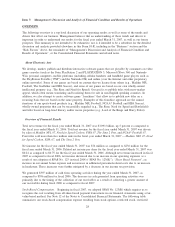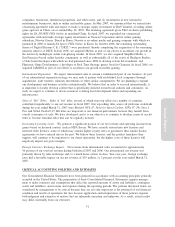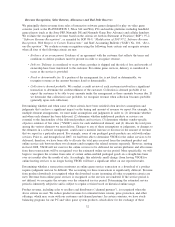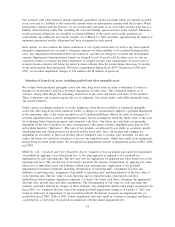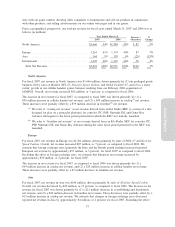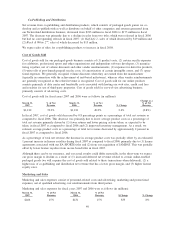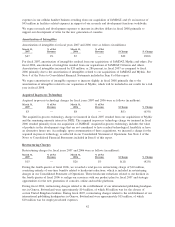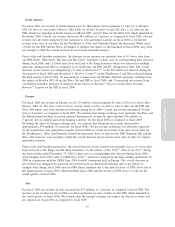Electronic Arts 2007 Annual Report Download - page 109
Download and view the complete annual report
Please find page 109 of the 2007 Electronic Arts annual report below. You can navigate through the pages in the report by either clicking on the pages listed below, or by using the keyword search tool below to find specific information within the annual report.
Stock-Based Compensation
On April 1, 2006, we adopted SFAS No. 123(R) and applied the provisions of SAB No. 107, “Share-Based
Payment”, on our adoption of SFAS No. 123(R). SFAS No. 123(R) requires that the cost resulting from all
share-based payment transactions be recognized in the financial statements using a fair-value-based method.
We elected to use the modified prospective transition method of adoption. SFAS No. 123(R) requires us to
measure compensation cost for all outstanding unvested stock-based awards made to our employees and
directors based on estimated fair values and recognize compensation over the service period for awards
expected to vest. We recognized $133 million of stock-based compensation related to employee stock options,
restricted stock units, restricted stock awards and our employee stock purchase plan (“ESPP”) during the fiscal
year ended March 31, 2007. We recognized $3 million of stock-based compensation related to employee
restricted stock units, stock options assumed in connection with our acquisition of JAMDAT and non-employee
stock options during the fiscal year ended March 31, 2006. We recognized $6 million of stock-based
compensation related to stock options assumed in connection with our acquisition of Criterion Software Group
Ltd. and non-employee stock options and warrants during the fiscal year ended March 31, 2005.
For options and ESPP, we use the Black-Scholes option valuation model to determine the grant date fair value.
The Black-Scholes option valuation model requires us to make certain assumptions about the future. The
determination of fair value is affected by our stock price as well as assumptions regarding subjective and
complex variables such as expected employee exercise behavior and our expected stock price volatility over
the term of the award. Generally, our assumptions are based on historical information and judgment is required
to determine if historical trends may be indicators of future outcomes. We estimated the following key
assumptions for the Black-Scholes valuation calculation:
•Risk-free interest rate. The risk-free interest rate is based on U.S. Treasury yields in effect at the time
of grant for the expected term of the option.
•Expected volatility. We use our historical stock price volatility and consider the implied volatility
computed based on the price of short-term options publicly traded on our common stock for our
expected volatility assumption.
•Expected term. The expected term represents the weighted-average period the stock options are
expected to remain outstanding. The expected term is determined based on historical exercise behavior,
post-vesting termination patterns, options outstanding and future expected exercise behavior.
•Expected dividends.
As required by SFAS No. 123(R), employee stock-based compensation expense recognized in fiscal 2007 was
calculated based on awards ultimately expected to vest and has been reduced for estimated forfeitures.
Forfeitures are revised, if necessary, in subsequent periods if actual forfeitures differ from those estimates and
an adjustment will be recognized at that time.
Changes to our underlying stock price, our assumptions used in the Black-Scholes option valuation calculation
and our forfeiture rate as well as future grants of equity could significantly impact compensation expense to be
recognized in fiscal 2008 and future periods.
Income Taxes
In the ordinary course of our business, there are many transactions and calculations where the tax law and
ultimate tax determination is uncertain. As part of the process of preparing our Consolidated Financial
Statements, we are required to estimate our income taxes in each of the jurisdictions in which we operate prior
to the completion and filing of tax returns for such periods. This process requires estimating both our
geographic mix of income and our current tax exposures in each jurisdiction where we operate. These
estimates involve complex issues, require extended periods of time to resolve, and require us to make
judgments, such as anticipating the positions that we will take on tax returns prior to our actually preparing
the returns and the outcomes of disputes with tax authorities. We are also required to make determinations of
the need to record deferred tax liabilities and the recoverability of deferred tax assets. A valuation allowance is
Annual Report
35





